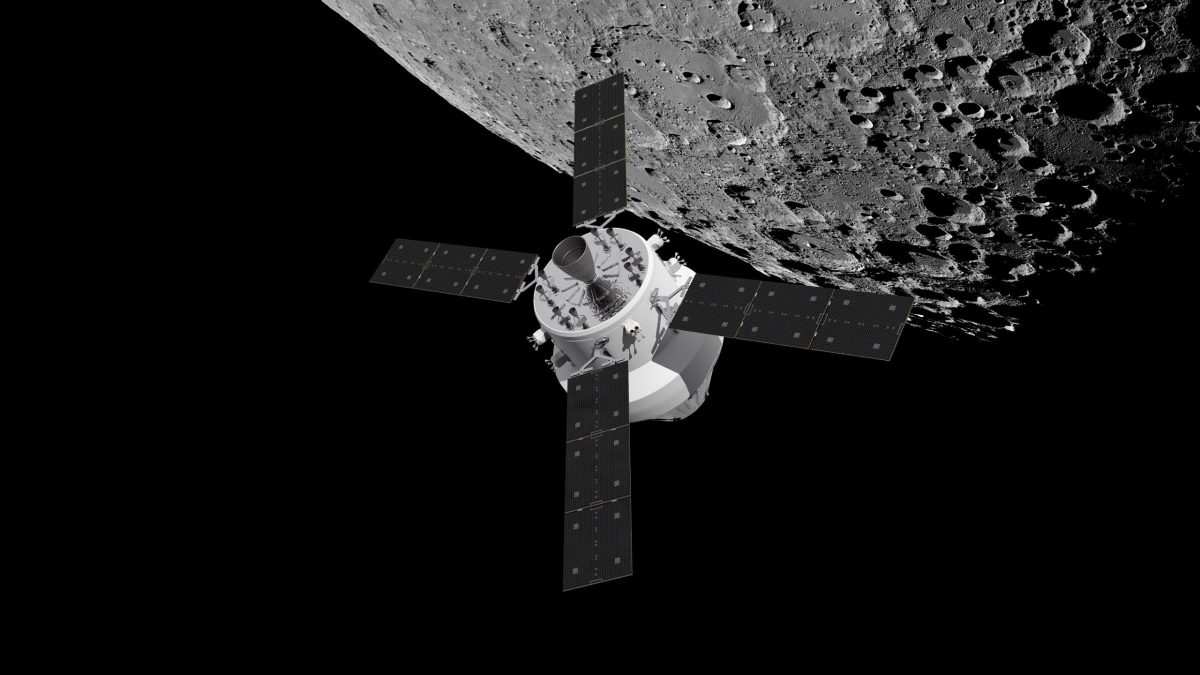Artist’s impression of Orion over the Moon. Orion was designed to send astronauts further into space than ever before, beyond the Moon to asteroids and even Mars. Credit: NASA/ESA/ATG Medialab
On Wednesday, November 30, NASA’s Artemis I mission management team met to review the overall status of the flight test. They polled “go” for Orion to depart from its distant retrograde orbit, where it has been since November 25. On Thursday, December 1, at 3:53 p.m. CST, Orion will conduct a burn to depart the orbit and begin its trek back toward Earth.
“We are continuing to collect flight test data and buy down risk for crewed flight,” said Mike Sarafin, Artemis mission manager. “We continue to learn how the system is performing, where our margins are, and how to operate and work with the vehicle as an integrated team.”
On Flight Day 15, Orion also performed a planned orbit maintenance burn to maintain the spacecraft’s trajectory and decrease its velocity ahead of its Thursday departure from a distant lunar orbit. During the burn, Orion used six of its auxiliary thrusters on the European Service module to fire for 95 seconds.
Initially, the burn was planned for a shorter duration but was lengthened as part of the team’s effort to add test objectives to the mission. The 95-second burn provided additional data to characterize the thrusters and the radiative heating on the spacecraft’s solar array wings to help inform Orion’s operational constraints. All previous thruster burns were 17 seconds or less.

Artemis I is the first integrated flight test of NASA’s deep space exploration system: the Orion spacecraft, Space Launch System (SLS) rocket, and the ground systems at Kennedy Space Center in Cape Canaveral, Florida. The first in a series of increasingly complex missions, Artemis I is an uncrewed flight that will provide a foundation for human deep space exploration, and demonstrate our commitment and capability to extend human existence to the Moon and beyond. Credit: NASA
Orion’s European-built service module has provided the propulsive capabilities to adjust the spacecraft’s course in space via its 33 engines of various types. In addition to propulsion, it also serves as Orion’s powerhouse, supplying it will electricity, thermal control, and air and water for future crews. Artemis I is the first time NASA is using a European-built system as a critical element to power an American spacecraft. Provided by ESA (European Space Agency) and its partner Airbus Defence and Space, the service module extends NASA’s international cooperation from the International Space Station into deep space exploration.
Under Artemis, NASA is continuing to extend its relationships with its international partners to explore the Moon. The agency’s Gateway, a multi-purpose outpost in development to orbit the Moon that will provide essential support for long-term lunar exploration, includes contributions from ESA as well as the Canadian Space Agency and the Japan Aerospace Exploration Agency. Agencywide, NASA has more than 600 active international agreements with organizations and space agencies around the world.

On flight day 13, Orion reached its maximum distance from Earth during the Artemis I mission when it was 268,563 miles (432,210 km) away from our home planet. Orion has now traveled farther than any other spacecraft built for humans. Credit: NASA
Teams also elected to add four additional test objectives to Orion’s return trip to Earth to gather additional data on the spacecraft’s capabilities. Two will evaluate whether opening and closing a valve the pressure control assembly affects a slow leak rate in that system; a third will demonstrate Orion’s ability to perform attitude maneuvers at the rate that will be necessary for a test on Artemis II; and the fourth will test its capability to fly in a three degree of freedom attitude control mode, as opposed to the six degree of freedom mode it typically flies in.
Prior to today’s orbital maintenance burn, a total of 5,681 pounds of propellant had been used, 203 pounds less than values expected before launch. Some 2,004 pounds of margin is available beyond what is planned for use during the mission, a 94-pound increase above prelaunch expected values.
Just after 4 p.m. CST on November 30, Orion was traveling 253,079 miles (407,291 km) from Earth and 50,901 miles (81,917 km) from the Moon, cruising at 2,052 mph (3,302 km/h).
Coverage of the distant retrograde orbit departure burn will begin Thursday at 3:30 p.m. CST, with the burn scheduled to occur at 3:53 p.m. Watch live on NASA TV, the agency’s website, and the NASA app.
Share your story or advertise with us: Whatsapp: +2347068606071 Email: info@newspotng.com












